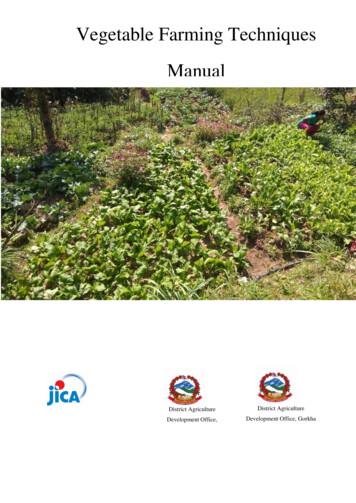
Transcription
India is an agriculturally important country.Two-thirds of its population is engaged inagricultural activities. Agriculture is a primaryactivity, which produces most of the food thatwe consume. Besides food grains, it alsoproduces raw material for various industries.through natural processes; land productivityin this type of agriculture is low as the farmerdoes not use fertilisers or other moderninputs. It is known by different names indifferent parts of the country.Can you name some industries based onagricultural raw material?It is jhumming in north-eastern states likeAssam, Meghalaya, Mizoram and Nagaland;Pamlou in Manipur, Dipa in Bastar district ofChhattishgarh, and in Andaman and NicobarIslands.Moreover, some agricultural products liketea, coffee, spices, etc. are also exported.TYPES OF FARMINGAgriculture is an age-old economic activity inour country. Over these years, cultivationmethods have changed significantly dependingupon the characteristics of physicalenvironment, technological know-how andsocio-cultural practices. Farming varies fromsubsistence to commercial type. At present, indifferent parts of India, the following farmingsystems are practised.Primitive Subsistence FarmingThis type of farming is still practised in fewpockets of India. Primitive subsistenceagriculture is practised on small patches ofland with the help of primitive tools like hoe,dao and digging sticks, and family/communitylabour. This type of farming depends uponmonsoon, natural fertility of the soil andsuitability of other environmental conditionsto the crops grown.It is a ‘slash and burn’ agriculture.Farmers clear a patch of land and producecereals and other food crops to sustain theirfamily. When the soil fertility decreases, thefarmers shift and clear a fresh patch of landfor cultivation. This type of shifting allowsNature to replenish the fertility of the soilCan you name some such types of farmings?Jhumming: The ‘slash and burn’ agricultureis known as ‘Milpa’ in Mexico and CentralAmerica, ‘Conuco’ in Venzuela, ‘Roca’ inBrazil, ‘Masole’ in Central Africa, ‘Ladang’in Indonesia, ‘Ray’ in Vietnam.In India, this primitive form of cultivationis called ‘Bewar’ or ‘Dahiya’ in MadhyaPradesh, ‘Podu’ or ‘Penda’ in Andhra Pradesh,‘Pama Dabi’ or ‘Koman’ or Bringa’ in Odisha,‘Kumari’ in Western Ghats, ‘Valre’ or ‘Waltre’in South-eastern Rajasthan, ‘Khil’ in theHimalayan belt, ‘Kuruwa’ in Jharkhand, and‘Jhumming’ in the North-eastern region.Fig. 4.12015-16
Rinjha lived with her family in a small villageat the outskirts of Diphu in Assam. She enjoyswatching her family members clearing,slashing and burning a patch of land forcultivation. She often helps them in irrigatingthe fields with water running through abamboo canal from the nearby spring. Sheloves the surroundings and wants to stayhere as long as she can, but this little girlhas no idea about the declining fertility ofthe soil and her family’s search for fresh apatch of land in the next season.Plantation is also a type of commercialfarming. In this type of farming, a single cropis grown on a large area. The plantation hasan interface of agriculture and industry.Plantations cover large tracts of land, usingcapital intensive inputs, with the help ofmigrant labourers. All the produce is used asraw material in respective industries.In India, tea, coffee, rubber, sugarcane,banana, etc. are important plantation crops.Tea in Assam and North Bengal coffee inCan you name the type of farming Rinjha’sfamily is engaged in?Can you enlist some crops which are grownin such far ming?Intensive Subsistence FarmingThis type of farming is practised in areas ofhigh population pressure on land. It is labourintensive farming, where high doses ofbiochemical inputs and irrigation are used forobtaining higher production.Fig. 4.2: Banana plantation in Southernpart of IndiaCan you name some of the states of Indiawhere such farming is practised?Though the ‘right of inheritance’ leading tothe division of land among successivegenerations has rendered land-holding sizeuneconomical, the farmers continue to takemaximum output from the limited land in theabsence of alternative source of livelihood.Thus, there is enormous pressure onagricultural land.Commercial FarmingThe main characteristic of this type of farmingis the use of higher doses of modern inputs,e.g. high yielding variety (HYV) seeds, chemicalfertilisers, insecticides and pesticides in orderto obtain higher productivity. The degree ofcommercialisation of agriculture varies fromone region to another. For example, rice is acommercial crop in Haryana and Punjab, butin Odisha, it is a subsistence crop.Can you give some more examples of cropswhich may be commercial in one region andmay provide subsistence in another region?Fig. 4.3: Bamboo plantation in North-eastKarnataka are some of the important plantationcrops grown in these states. Since theproduction is mainly for market, a welldeveloped network of transport andcommunication connecting the plantationareas, processing industries and markets playsan important role in the development ofplantations.A GRICULTURE352015-16
CROPPING PATTERNYou have studied the physical diversities andplurality of cultures in India. These are alsoreflected in agricultural practices andcropping patterns in the country. Varioustypes of food and fibre crops, vegetables andfruits, spices and condiments, etc. constitutesome of the important crops grown in thecountry. India has three cropping seasons —rabi, kharif and zaid.Rabi crops are sown in winter from Octoberto December and harvested in summer fromApril to June. Some of the important rabi cropsare wheat, barley, peas, gram and mustard.Though, these crops are grown in large partsof India, states from the north and northwestern parts such as Punjab, Haryana,Himachal Pradesh, Jammu and Kashmir,Uttarakhand and Uttar Pradesh are importantfor the production of wheat and other rabicrops. Availability of precipitation duringwinter months due to the western temperatecyclones helps in the success of these crops.However, the success of the green revolutionin Punjab, Haryana, western Uttar Pradeshand parts of Rajasthan has also been animportant factor in the growth of the abovementioned rabi crops.Kharif crops are grown with the onset ofmonsoon in different parts of the country andthese are harvested in September-October.Important crops grown during this season arepaddy, maize, jowar, bajra, tur (arhar), moong,urad, cotton, jute, groundnut and soyabean.Some of the most important rice-growingregions are Assam, West Bengal, coastal regionsof Odisha, Andhra Pradesh, Telangana, TamilNadu, Kerala and Maharashtra, particularlythe (Konkan coast) along with Uttar Pradeshand Bihar. Recently, paddy has also becomean important crop of Punjab and Haryana. Instates like Assam, West Bengal and Odisha,three crops of paddy are grown in a year. Theseare Aus, Aman and Boro.In between the rabi and the kharif seasons,there is a short season during the summermonths known as the Zaid season. Some ofthe crops produced during ‘zaid’ arewatermelon, muskmelon, cucumber,36vegetables and fodder crops. Sugarcane takesalmost a year to grow.Major CropsA variety of food and non food crops are grownin different parts of the country dependingupon the variations in soil, climate andcultivation practices. Major crops grown inIndia are rice, wheat, millets, pulses, tea, coffee,sugarcane, oil seeds, cotton and jute, etc.Rice: It is the staple food crop of a majority ofthe people in India. Our country is the secondlargest producer of rice in the world after China.It is a kharif crop which requires hightemperature, (above 25 C) and high humiditywith annual rainfall above 100 cm. In the areasof less rainfall, it grows with the help of irrigation.Rice is grown in the plains of north andnorth-eastern India, coastal areas and thedeltaic regions. Development of dense networkFig. 4.4 (a): Rice CultivationFig. 4.4 (b): Rice is ready to be harvested in the fieldCONTEMPORARY INDIA – II2015-16
India: Distribution of RiceA GRICULTURE372015-16
of canal irrigation and tubewells have made itpossible to grow rice in areas of less rainfallsuch as Punjab, Haryana and western UttarPradesh and parts of Rajasthan.Wheat: This is the second most importantcereal crop. It is the main food crop, in northand north-western part of the country. Thisrabi crop requires a cool growing season anda bright sunshine at the time of ripening. Itrequires 50 to 75 cm of annual rainfall evenlydistributed over the growing season. There aretwo important wheat-growing zones in thecountry – the Ganga-Satluj plains in the northwest and black soil region of the Deccan. Themajor wheat-producing states are Punjab,Haryana, Uttar Pradesh, Bihar, Rajasthan andparts of Madhya Pradesh.Fig. 4.6: Bajra Cultivationcrop of dry regions and grows well on red,black, sandy, loamy and shallow black soils.Major ragi producing states are: Karnataka,Tamil Nadu, Himachal Pradesh, Uttarakhand,Sikkim, Jharkhand and Arunachal Pradesh.Maize: It is a crop which is used both as foodand fodder. It is a kharif crop which requirestemperature between 21 C to 27 C and growswell in old alluvial soil. In some states like BiharFig. 4.5: Wheat CultivationMillets: Jowar, bajra and ragi are theimportant millets grown in India. Though,these are known as coarse grains, they havevery high nutritional value. For example, ragiis very rich in iron, calcium, other micronutrients and roughage. Jowar is the thirdmost important food crop with respect to areaand production. It is a rain-fed crop mostlygrown in the moist areas which hardly needsirrigation. Major Jowar producing States wereMaharashtra, Karnataka, Andhra Pradesh andMadhya Pradesh in 2011-12.Bajra grows well on sandy soils and shallowblack soil. Major Bajra producing States were:Rajasthan, Uttar Pradesh, Maharashtra,Gujarat and Haryana in 2011-12. Ragi is a38Fig. 4.7: Maize Cultivationmaize is grown in rabi season also. Use of moderninputs such as HYV seeds, fertilisers and irrigationhave contributed to the increasing production ofmaize. Major maize-producing states areKarnataka, Uttar Pradesh, Bihar, AndhraPradesh, Telangana and Madhya Pradesh.Pulses: India is the largest producer as wellas the consumer of pulses in the world. Theseare the major source of protein in a vegetariandiet. Major pulses that are grown in India aretur (arhar), urad, moong, masur, peas andCONTEMPORARY INDIA – II2015-16
India: Distribution of WheatA GRICULTURE392015-16
gram. Can you distinguish which of thesepulses are grown in the kharif season andwhich are grown in the rabi season? Pulsesneed less moisture and survive even in dryconditions. Being leguminous crops, all thesecrops except arhar help in restoring soil fertilityby fixing nitrogen from the air. Therefore, theseare mostly grown in rotation with other crops.Major pulse producing states in India areMadhya Pradesh, Uttar Pradesh, Rajasthan,Maharashtra and Karnataka.Food Crops other than GrainsSugarcane: It is a tropical as well as asubtropical crop. It grows well in hot andhumid climate with a temperature of 21 C to27 C and an annual rainfall between 75cm.and 100cm. Irrigation is required in the regionsof low rainfall. It can be grown on a variety ofFig. 4.8: Sugarcane Cultivationsoils and needs manual labour from sowing toharvesting. India is the second largest producerof sugarcane only after Brazil. It is the mainsource of sugar, gur (jaggary), khandsari andmolasses. The major sugarcane-producingstates are Uttar Pradesh, Maharashtra,Karnataka, Tamil Nadu, Andhra Pradesh,Telangana, Bihar, Punjab and Haryana.Oil Seeds: In 2008 India was the secondlargest producer of groundnut in the worldafter china. In rape seed production India wasthird largest producer in the world afterCanada and China in 2008. Different oil seedsare grown covering approximately 12 per centof the total cropped area of the country. Mainoil-seeds produced in India are groundnut,mustard, coconut, sesamum (til), soyabean,castor seeds, cotton seeds, linseed andsunflower. Most of these are edible and usedas cooking mediums. However, some of theseare also used as raw material in the productionof soap, cosmetics and ointments.Groundnut is a kharif crop and accountsfor about half of the major oilseeds produced inthe country. Gujarat was the largest producerof groundnut followed by Andhra Pradesh andTamil Nadu in 2011-12. Linseed and mustardare rabi crops. Sesamum is a kharif crop in northand rabi crop in south India. Castor seed isgrown both as rabi and kharif crop.Tea: Tea cultivation is an example ofplantation agriculture. It is also an importantbeverage crop introduced in India initially bythe British. Today, most of the tea plantationsare owned by Indians. The tea plant grows wellin tropical and sub-tropical climates endowedwith deep and fertile well-drained soil, rich inhumus and organic matter. Tea bushesrequire warm and moist frost-free climate allthrough the year. Frequent showers evenlydistributed over the year ensure continuousgrowth of tender leaves. Tea is a labourintensive industry. It requires abundant,Fig. 4.9: Groundnut, sunflower and mustard are ready to be harvested in the field40CONTEMPORARY INDIA – II2015-16
cheap and skilled labour.Tea is processed withinthe tea garden to restoreits freshness. Major teaproducing states areAssam, hills of Darjeelingand Jalpaiguri districts,West Bengal, Tamil Naduand Kerala. Apart fromthese, Himachal Pradesh,Fig. 4.10: Tea CultivationFig. 4.11: Tea-leaves HarvestingUttarakhand, Meghalaya,Andhra Pradesh andTripura are also tea-producing states in thetropical as well as temperate fruits. Mangoescountry. In 2008 India was the third largestof Maharashtra, Andhra Pradesh, Telangana,producer of tea after China and Turkey.Uttar Pradesh and West Bengal, oranges ofCoffee: In 2008 India produced 3.2 per centof the world coffee production. Indian coffee isknown in the world for its good quality. TheArabica var
It is a ‘slash and burn’ agriculture. Farmers clear a patch of land and produce cereals and other food crops to sustain their family. When the soil fertility decreases, the farmers shift and clear a fresh patch of land for cultivation. This type of shifting allows Nature to replenish the fertility of the soil through natural processes; land productivity in this type of agriculture is low .











